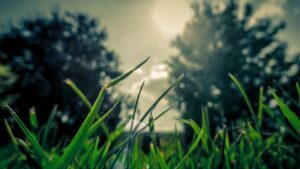People generally have a love/hate relationship with winter. Some love the feeling of cuddling up next to an open fire and reading a good book, others hate the thought of the cold, the limited sunlight and the persistent rain.
Much like people, some lawns will enjoy the cool conditions, others will not. Handily, grasses can generally be placed into one of two categories – warm season and cool season. Warm season grasses prefer the heat and sun, while cool season grasses fare better in cooler, wetter conditions. But no matter which grass type lines your backyard, there’s no need to fret; each variety is able to get through the coolest time of year relatively unscathed, provided its owner is happy to help it out.
So which varieties will do well, and which may not? And what might specifically be required of you? Let’s take a look.

Cool Season Grasses
The likes of Ryegrass, Fescue and Kentucky Bluegrass are all cool season grasses, common to the more temperate areas of Australia such as Victoria and Tasmania. While these grasses can brown off during the heat of summer, they come into their own during late autumn.
Generally speaking these grasses enjoy the damp conditions offered up by the winter rains of Australia’s southern regions, and are tolerant to frosts. They don’t need a huge amount of sunlight to grow, and will experience their peak growing periods as the weather slightly warms in early spring.
Those with cool season lawns would be wise to fertilise their patches in late winter, in preparation for this peak growing period. Over and above that very little is required in order to keep the grass in good condition over the cooler months. Be sure to aerate your lawn before winter to assist with drainage and ensure that it doesn’t become waterlogged, and raise the height of your mower to give your lawn the greatest chance to make use of the often limited winter sun.

Warm Season Grasses
The Yin to the cool season grass Yang, warm season grasses such as Couch, Kikuyu, Buffalo and Zoysia are the go-to for most Australians. They will traditionally love the sun, be relatively drought tolerant and will grow best in warm soils.
While this set of characteristics is perfect for what most would consider to be ‘standard’ Australian weather, they aren’t ideal for those few months of the year that are a little more nippy. The lack of sun during the temperate Australian winter, combined with the odd frost and an abundance of rain, can have your warm season lawn struggling.
Generally warm season lawns will fall into a state of hibernation when the mercury falls below a particular point. This can give the impression that the grass is dying off, as the process can brown the blades of the plant, but there’s usually no need to worry, as the lawn will be simply redirecting its energies from the blades to the more important roots.
There are a few strategies that a warm season lawn owner can put in place in order to get his or her lawn through winter relatively unscathed. As with cool season varieties, you want to set your mower a little higher so as to maximise the amount of sun caught by the blade. Warm season grasses will experience their peak growing periods in autumn, when the weather is more moderate but the soil is still warm. You can use this fact to get your lawn as healthy as possible in the lead up to winter. Use a slow-release fertiliser to strengthen your grass, aerate and religiously weed your lawn, and ensure that is gets enough water.

By knowing what to expect from your lawn over winter, you’re perfectly placed to help the grass through this often challenging time of year. No matter whether you’ve got a lawn that is built for the conditions or one that needs a little assistance with the cold, it only takes a small amount of effort to get your lawn looking fantastic all year round.
Does perennial ryegrass come back every year?
Perennial ryegrass is a type of grass that does indeed come back every year. This is in contrast to annual ryegrass, which only lives for one growing season before dying off. Perennial ryegrass is a popular choice for lawns and turfgrass because it is very hardy and can withstand a lot of wear and tear. It is also relatively low-maintenance, requiring only occasional mowing and watering.
How do you care for perennial ryegrass?
Perennial ryegrass is a versatile and hardy grass that is easy to care for. It tolerates a wide range of soils and climates, and is relatively drought-resistant. However, like all grasses, it does require some basic maintenance in order to stay healthy and looking its best.
Mowing is the most important aspect of care for perennial ryegrass. It should be mowed regularly, at least once a week, to keep it from getting too tall. The height of the grass should be kept at around 3 inches. This will ensure that the grass stays dense and lush, and prevents it from developing bare patches.
Perennial ryegrass also needs to be fertilized periodically. A slow-release fertilizer should be applied every 6-8 weeks during the growing season. This will help the grass to maintain its green color and keep it from getting thin and weak.
Finally, perennial ryegrass needs to be watered regularly. It should be watered deeply and evenly, about 1 inch per week. This will help it to develop a deep root system and stay healthy during periods of drought.
How long does perennial ryegrass take to establish?
Perennial ryegrass is a type of grass that is often used for lawns, pastures, and other areas where a grassy surface is desired. It is a fast-growing grass that can establish itself quickly, often in as little as two weeks. Once established, it is a hardy grass that can tolerate a wide range of conditions, from drought to heavy traffic.
What time of year do you plant perennial ryegrass?
Perennial ryegrass is a cool-season grass, which means that it thrives in cooler temperatures and goes dormant in hot weather. In general, you should plant perennial ryegrass between Autumn and Spring, when the temperatures are cool. This gives the grass the best chance to establish itself.
Test
test
 Free Metro Shipping, orders over $75
Free Metro Shipping, orders over $75

